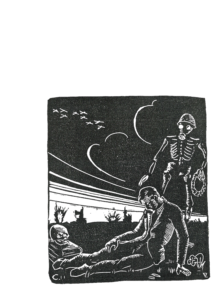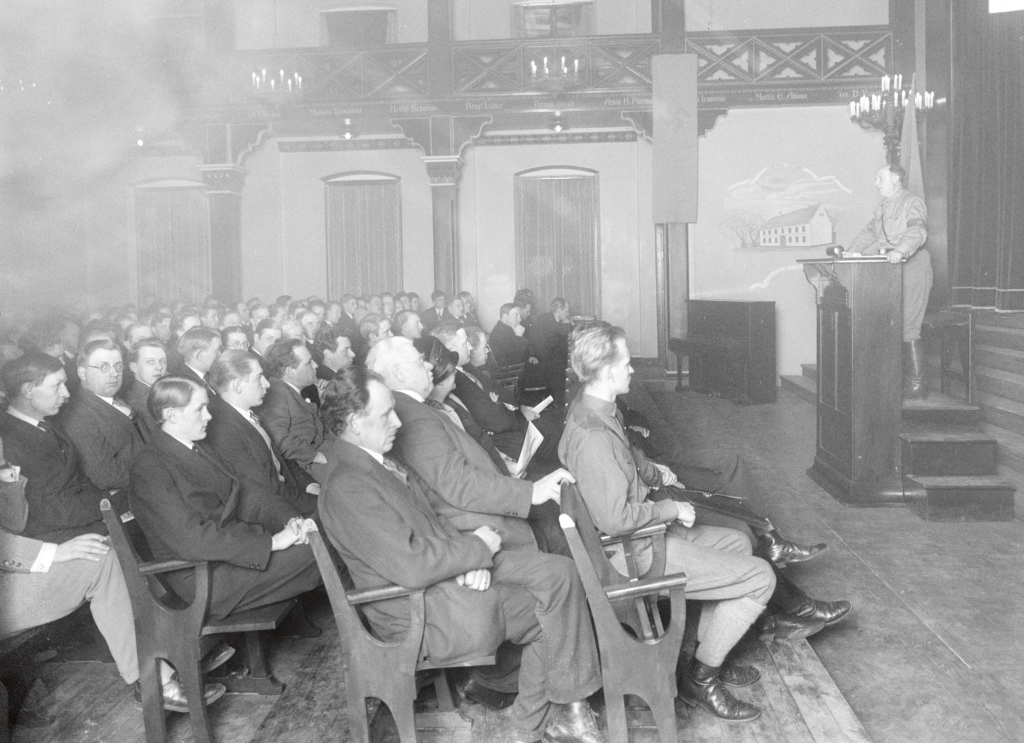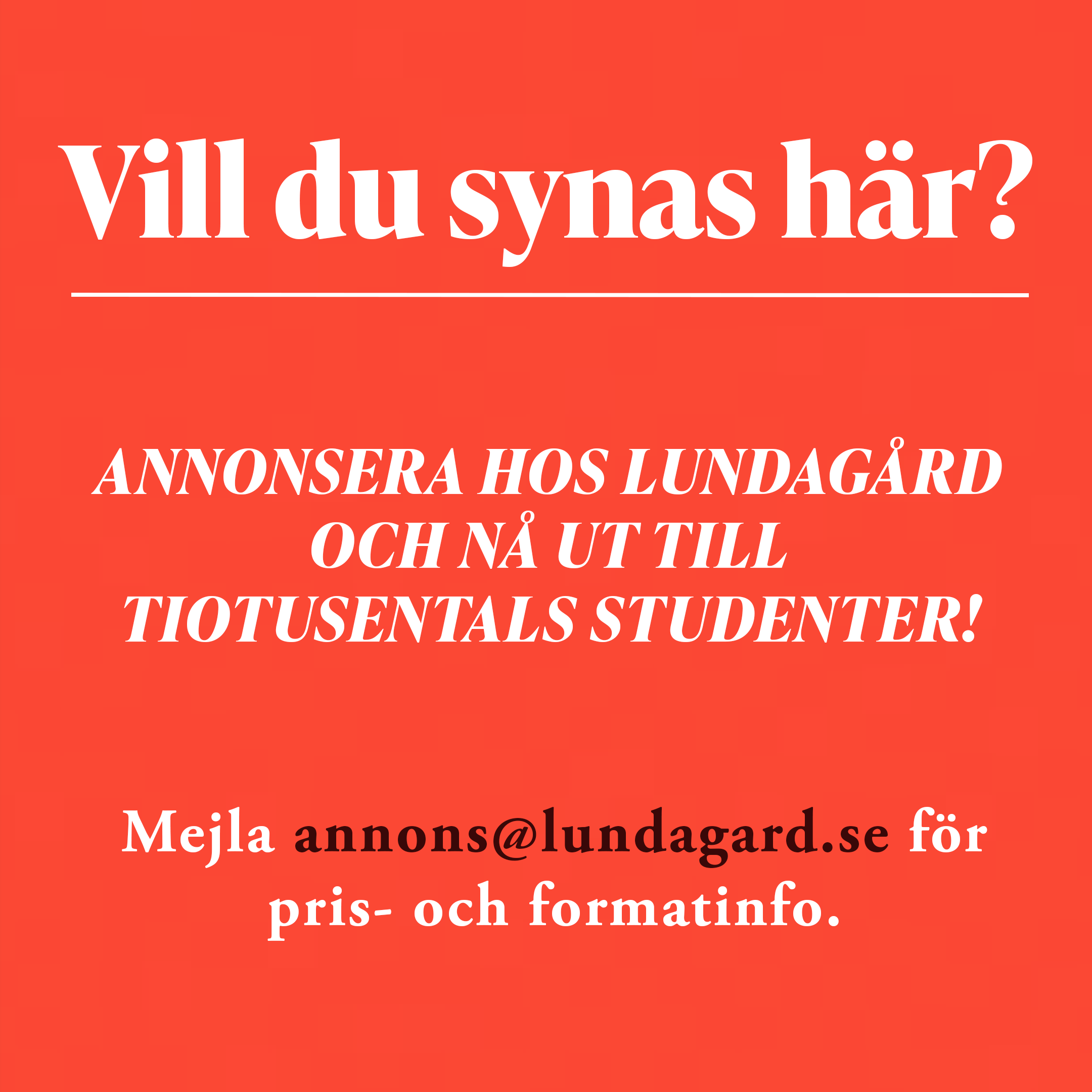Sweden was a “neutral” country during Hitler’s rampage. But how was the atmosphere among the students at Lund University? Lundagård has explored the student life’s dark history.
Populism, extremism, and, above all, fascism, is not expected from the intellectual elite in modern day society. On the contrary they are often believed to follow carefully calibrated moral compasses. However, the world is not only black or white and even the highly esteemed Lund University has a gray, or more accurately brown, history.
National socialist sympathies were common in Sweden during the 1930s and 1940s, and in academic environments like Lund the tendencies were even more prevalent. An undesirable renaissance took place in the 1980s and 1990s through the rise of the neo-Nazi movement. The devastating consequences of Nazism shall not be forgiven nor forgotten, yet past preconditions which allowed it to thrive must be accounted for to make any sense of the most regrettable acts of mankind.
Lundagård met with Ulf Zander, professor in history with multiple published books and articles about Nazism, the Holocaust and the World Wars, to address the dynamics at Lund University and in the student life throughout the 1930s and 1940s.
“I think the ability to hold two opposing ideas in mind at the same time is very important when looking at something like Nazism. Partially that national socialism has to be recognized as a very problematic ideology back in those days as well, and partially that we didn’t know then what we know now”, says Ulf Zander.
In 1981, Lundagård dedicated issue six and seven to confronting the questionable past of Lund during the second World War. One of the interviewees was former Lund student and Lundagård editor Allan Fagerström. He sympathized with Great Britain throughout the war, and described for the magazine how the political climate among the students did not allow for counter statements to be made. Instead he simply did not fraternize with peers who where pro Germany. There were also teachers that did not allow Jewish students to attend their lectures. The debate around Nazism was very central at the university campus and a fair amount of the students were politically engaged, Ulf Zander claims.
The Nazi party was not as universally despised in Sweden as we might retrospectively imagine. Swedish and German relations were rooted centuries back, especially in the scientific fields and academia. Most dissertations were printed in German as it was the most common second language. Swedish scientists were not prone to disrupt long-standing contacts solely due to the rise of a politically unpleasant regime.
Ulf Zander explains that Swedish citizens considered Germany a pioneer country, even if attitudes towards Hitler himself differed. Moreover, Sweden and Germany had a common enemy in Russia, a country which Sweden had historically been at war with several times. Antisemitism, an integral part of the Nazi ideology, existed in Sweden as well, but rather as a “background bustle”, Ulf Zander continues, and Jews were often made fun of in the contemporary comic press.
In February 1939 the Swedish Government decided to allocate money for the purpose of receiving Jewish refugees from Germany. This stirred up debates among students all over Sweden. The student union meeting on the March 5th 1939 is usually considered a key event in the national socialist history of Lund. On the agenda was a vote about whether 10–20 Jewish physicians were to be given residence as well as work permit in Sweden.
Two proposals had been formulated; one which was in favour of the Jewish physicians immigrating, and one against the “import of Jews”. The author of the latter proposal was the qurator of Kristianstad nation. The opponents of the anti-refugee agenda were an alliance of leftists, cultural radicals, and Christian students.
Nationalism was no strange bird, but rather a given. From there it was not a big leap to national socialism.
Lund University had approximately 2.200 enrolled students that semester, half of which participated in the meeting. The anti-refugee proposition won with 742 votes against 342. Kalmar was the only nation where the majority of members voted for the opposing side. Similar conventions had taken place in Uppsala and Stockholm the previous week, both resulting in the same outcome as in Lund: no Jewish refugees were welcome.
“There was no such thing as ‘widening participation’ (facilitating and increasing the participation of students from underrepresented groups in higher education, editors note) at the university back then. A majority of the students came from wealthy families and many brought conservative values with them from home. Nationalism was no strange bird, but rather a given. From there it was not a big leap to national socialism”, Ulf Zander points out.
The university ecosystem partly consisted of nationalist and outright Nazi student orginasations during the wartime, all of which disappeared as the tide turned in 1942-1943 when the Allied invaded the Axis powers and it dawned on the Nazi friends that Germany was losing the war. National socialist student organizations cannot be found in Lund anymore, but even some of the most notable establishments in modern Lund’s student life have stained histories.
Studentafton received German Nazi-affiliated film director Leni Riefenstahl on October 15th 1939 – she was regarded a very exciting guest. Her 1936 Summer Olympics propaganda documentary Olympia had been released the previous year and immediately became world renowned. On April 9th 1940 Studentafton hosted Leon Ljunglund, former editor in chief of the newspaper Nya Dagligt Allehanda. He urged a plea for Germany, and the audience responded with three lundian hoorays. This is captured in Sverker Oredssons book Lunds universitet under andra världskriget (“Lund University during the second World War”; Lunds universitetshistoriska sällskap, 1996).

Lundakarnavalen’s theme 1934 was “The Day of the Third Reich” and in the parade were “three little pigs”; Hitler, Goebbels and Göring. Nevertheless, Ulf Zander states that the spectacle was more of a commentary and “a mirror of laughter” than an homage to Germany, and that this was evident to the public perception.
Lundagård is credited to be “a fighting, outspoken and, given the time, admirably brave center of opposition to Nazism and Germany”, by the author and journalist Per Svensson. However, he recounts a time of wavering convictions from Lundagård in his book Vasakärven och järnröret (“The Grain and the Iron Pipe”; Weyler förlag, 2014). A new editorial, seen as more Nazi-friendly, was appointed under coup-like forms in 1941. Their reign was short-lived: Lundagård printed a short article in defense of a Norwegian academic who was imprisoned by the German occupying forces in 1942. It was deemed too understanding towards the Germans and the Nazi-friendly puppet regime they had imposed in Norway. Editor-in-chief Magnhild Rydén penned the precarious piece with the help of her fellow editors – all of which resigned after being received with great skepticism by the national press.
Despite what might appear as an abundance of Third Reich sympathizers, the Nazi ideology was never a dominating factor in Lund’s public life. In the beforementioned Lundagård issues from 1981 Ole Poppidan and Leon Levin were interviewed about coming to Lund as refugees in the final years of the war. Both of them arrived through what Ulf Zander describes as “an amazing relief action”, made possible by Sweden’s geographical and political distance from the war in mainland Europe. Ole Poppidan and Leon Levin describes Lund as an idyll, free from the national socialist movement – “nothing seemed to touch the slumbering city”.
If you investigate Nazism, you tend to find it everywhere.
Ulf Zander unravels the duality of history versus the recollections of those who were present.
“If you investigate Nazism, you tend to find it everywhere”, he reasons, “while eyewitnesses tend to find it difficult to put their experiences into a larger context, although they have precedence in interpreting the situations they were involved in”.
Regarding the extent of Nazism, it must be put in relation to something else.
“How many are ‘a few’ or ‘a lot’? It may be best to be content with stating that the Nazi movement had its adherents at Lund University. What we know for sure is that the longer the war lasted, the fewer they became”, Ulf Zander says.
Though difficult to grasp, the reminiscence of Nazism and its aftermath is haunting. Far-right extremist winds sweep across Europe and the national socialist strive for territorial expansion is once again on the radar. Ulf Zander summarizes by underlining the importance of comprehending that history is happening all the time. What we do now will be judged by generations to come.
“Being historical is realizing that you yourself are part of the process where values change over time. This is by no means a defense of anything having to do with Nazism, but I believe that it’s very important to try to understand why it attracted some people”.









